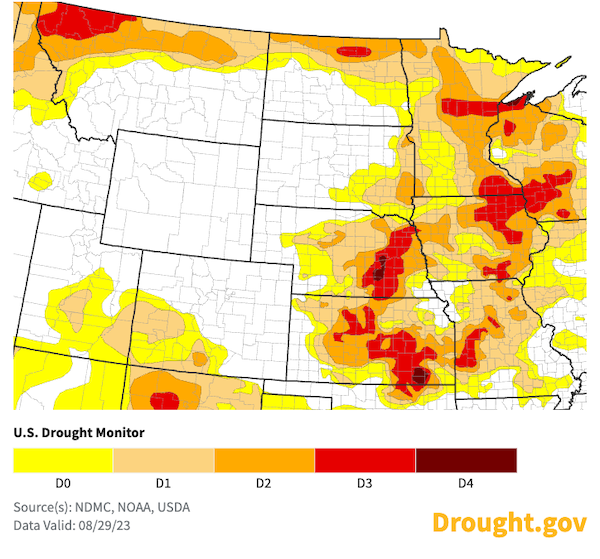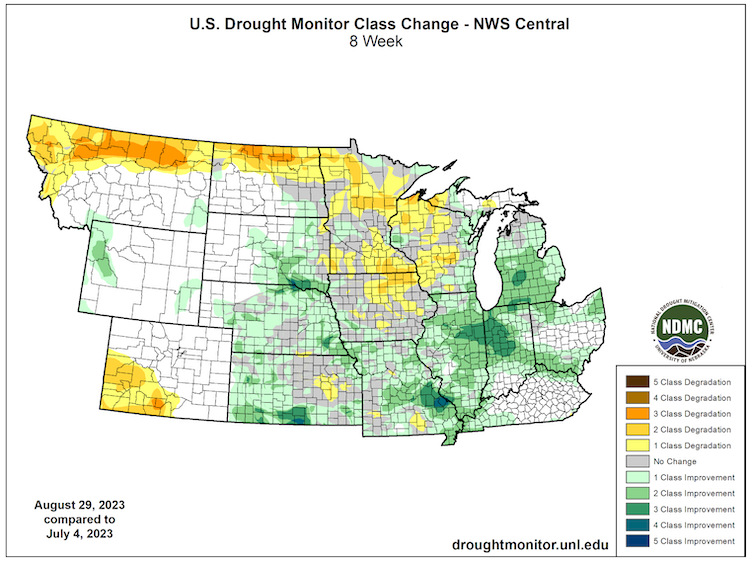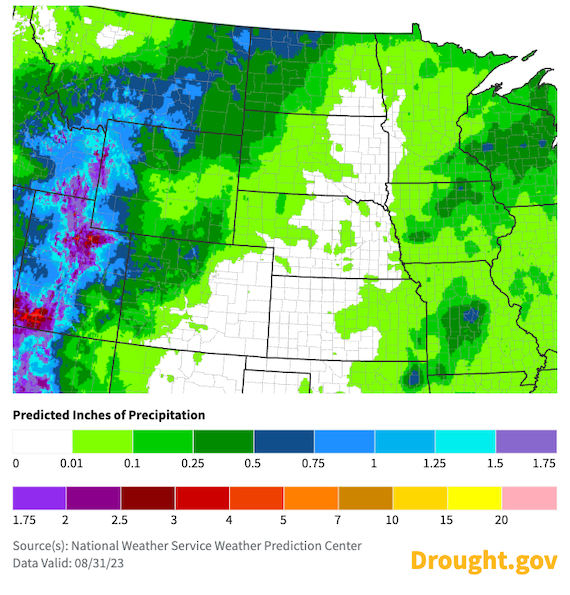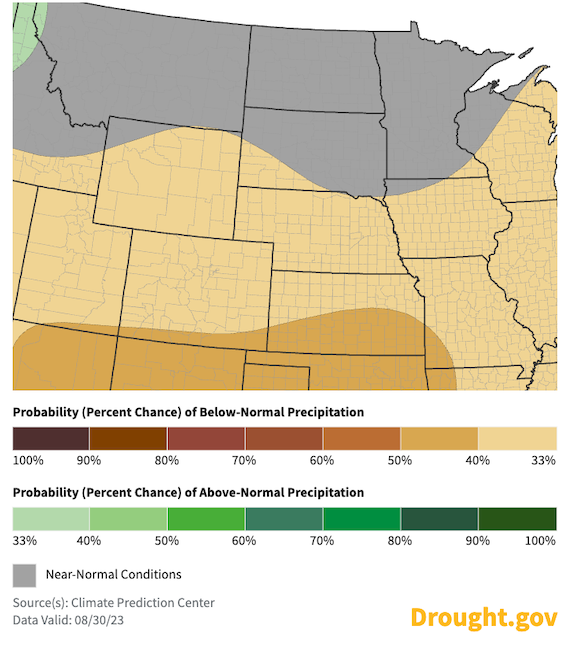Drought to Persist or Worsen in Portions of the Missouri River Basin Due to Continued Hot and Dry Conditions
Key Points
- According to the U.S. Drought Monitor, drought remains across 40% of the states within the Missouri River Basin, impacting portions of Kansas, Nebraska, North Dakota, Montana, Minnesota, Iowa, and Missouri (Figure 1).
- While there has been improvement since earlier this year, severe to exceptional drought (D2–D4) remains entrenched across Kansas (43% of the state) and Nebraska (28% of the state).
- Below-normal rainfall over the summer across portions of northern Montana and North Dakota, as well as eastern parts of the basin (Iowa, Missouri, eastern Kansas, central Nebraska), in addition to above-normal temperatures in some areas, drove the persistence and expansion of drought in these areas (Figure 2), particularly across northern North Dakota and Montana, where conditions have worsened over the last 8 weeks (Figure 3).
- Current drought impacts across the worst drought areas areas (Kansas, Nebraska, northern North Dakota, northern Montana, Missouri, Iowa, and Minnesota) include limited soil moisture for vegetation and potential crop yield reduction, poor pasture conditions forcing supplementary feeding for livestock, reduced surface water on streams and ponds/lakes, and water quality issues for livestock ponds in North Dakota. USDA Drought Disaster Designations have been declared for 88 counties in Nebraska and 84 counties in Kansas.
- Runoff has been near normal on the Missouri River, but due to the ongoing drought conditions, the U.S. Army Corps of Engineers has reduced the service level to conserve water. The current service level is 35,000 cubic feet per second (cfs), which is 1,500 cfs below full service.
- After a significant heat wave during the week of August 21, temperatures cooled starting August 26, but forecasts are calling for near to record heat to return this weekend, and the heat will likely persist through at least mid-September (Figure 4).
- Western and upper portions of the Basin may see some limited precipitation from August 31–September 7, but widespread significant rainfall is limited over the next week (Figure 5). This dry pattern is likely to continue, as the precipitation outlook shows greater chances for below-normal precipitation for September 7–13 across more southern portions of the Basin (Colorado, Wyoming, Kansas, Nebraska, Missouri) (Figure 6).
- The combination of hot and dry conditions through mid-September means drought conditions will likely persist and potentially worsen across parts of the Basin. Potential impacts include the continuation of current impacts listed above—along with moisture-stressed soybeans, which are in a critical growth stage right now—premature crop maturity (and associated yield loss), and increased fire risk.
Report Your Local Impacts
As conditions evolve, accurate reports on conditions and drought impacts are critical. Whether your area is currently wet, close to normal, or dry, please consider reporting conditions and any drought impacts you see or hear via the Condition Monitoring Observer Reports (CMOR) from the National Drought Mitigation Center. If you are already a CoCoRaHS observer, we encourage you to submit a Condition Monitoring Report.
Current Conditions
Figure 1. U.S. Drought Monitor (Valid August 29, 2023)

Figure 2. 90-Day Percent of Normal Precipitation (June 2–August 30, 2023)

Figure 3. U.S. Drought Monitor 8-Week Change Map (Since July 4, 2023)

Outlooks and Forecasts
Figure 4. 8–14 Day Temperature Outlook (Valid September 7–13, 2023)

Figure 5. Quantitative Precipitation Forecast for the Next 7 Days (August 31–September 7, 2023)

Figure 6. 8–14 Day Precipitation Outlook (Valid September 7–13, 2023)

Resources
Resources for Monitoring Drought & Heat Risk
- Keep track of the risk for extreme heat in the next 3–7 days with the U.S. Day 3–7 Hazards Outlook.
- Keep track of the risk of rapid drought onset and heat risk in the next 8–14 days with the U.S. Week 2 Hazards Outlook.
- Keep track of how much soil moisture there is compared to normal with various soil moisture products.
- Keep track of temperatures across the region with the Midwest Climate Watch Daily Maps for the Central U.S.
Heat Health Resources
- Climate and Health Outlook - August 2023 from the Department of Health and Human Services.
- Heat Illness Prevention information from the National Integrated Heat Health Information System (NIHHIS).
- Tips on staying safe in extreme heat from the Centers for Disease Control and Prevention (CDC).
- Heat Safety Tips and Resources from the National Weather Service.
For More Information
- NIDIS and its partners will issue future updates as conditions evolve.
- A special thank you to the state climate offices and National Weather Service offices in the Missouri River Basin for providing local information on drought conditions and impacts included in the webinar and on this report.
- More local information is available from the following resources:
- To report or view local drought impact information:
- Report your Drought Impacts through Condition Monitoring Observer Reports (CMOR)
- View CoCoRaHS Condition Monitoring reports.
- The upcoming North Central U.S. Climate and Drought Summary & Outlook Webinar on September 21, 2023 will offer updated information about conditions, impacts, and outlooks.
Prepared By
Molly Woloszyn
NOAA/National Integrated Drought Information System (NIDIS), CIRES/CU Boulder
Doug Kluck
NOAA/National Centers for Environmental Information
Dannele Peck & Dennis Todey
USDA Northern Plains Climate Hub and Midwest Climate Hub
Audra Bruschi
NOAA/National Weather Service Central Region
Kevin Low
NOAA/Missouri Basin River Forecast Center
Gannon Rush & Rezaul Mahmood
High Plains Regional Climate Center/University of Nebraska-Lincoln
Denise Gutzmer
National Drought Mitigation Center/University of Nebraska-Lincoln
Hunter Jones & Morgan Zabow
NOAA/National Integrated Heat Health Information System
This drought status update is issued in partnership between the National Oceanic and Atmospheric Administration (NOAA) and the U.S. Department of Agriculture (USDA) to communicate a potential area of concern for drought expansion and/or development within the Missouri River Basin based on recent conditions and the upcoming forecast. NIDIS and its partners will issue future drought status updates as conditions evolve.











